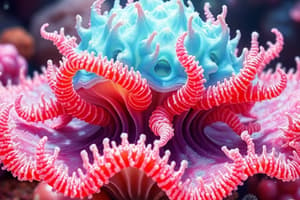Podcast
Questions and Answers
Which organisms are known as the architects of the ocean floor in the phylum Cnidaria?
Which organisms are known as the architects of the ocean floor in the phylum Cnidaria?
- Horny corals (correct)
- Sea anemones
- Jellyfishes
- Hydroids
What is the characteristic cell of the phylum Cnidaria?
What is the characteristic cell of the phylum Cnidaria?
- Nematocysts
- Chloroplasts
- Cnidocytes (correct)
- Flagella
Which group of organisms also utilize stinging structures for their own defense, similar to cnidarians?
Which group of organisms also utilize stinging structures for their own defense, similar to cnidarians?
- Ctenophores
- Molluscs
- Flatworms
- All of the above (correct)
What is the total number of species in the phylum Cnidaria?
What is the total number of species in the phylum Cnidaria?
What are the two types of corals mentioned in the text?
What are the two types of corals mentioned in the text?
What is the significance of cnidocytes in the phylum Cnidaria?
What is the significance of cnidocytes in the phylum Cnidaria?
Which organisms eat hydroids bearing nematocysts and use the stinging structures for their own defense?
Which organisms eat hydroids bearing nematocysts and use the stinging structures for their own defense?
What are the nature’s strangest and loveliest creatures mentioned in the text?
What are the nature’s strangest and loveliest creatures mentioned in the text?
True or false: Cnidaria includes only jellyfishes and corals, and no other types of creatures
True or false: Cnidaria includes only jellyfishes and corals, and no other types of creatures
True or false: Cnidocytes are formed by cnidarians, ctenophores, molluscs, and flatworms
True or false: Cnidocytes are formed by cnidarians, ctenophores, molluscs, and flatworms
True or false: Cnidaria is not named after the characteristic cells called cnidocytes
True or false: Cnidaria is not named after the characteristic cells called cnidocytes
True or false: The calcareous house-building of stony corals has produced great reefs and coral islands over hundreds of years
True or false: The calcareous house-building of stony corals has produced great reefs and coral islands over hundreds of years
Flashcards are hidden until you start studying




